Is it possible to presoak the T-shirts in the Soda Ash, wring it out and let the shirts dry, before tie dyeing later?
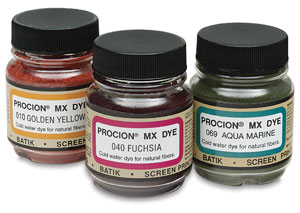
Procion dyes are permanent, colorfast, and very washable. You can easily create a palette of brilliant colors ranging from light pastels to deep, vibrant hues. Perfect for natural plant fibers - cotton, linen, paper, reeds, and wood.
Buy from Blick
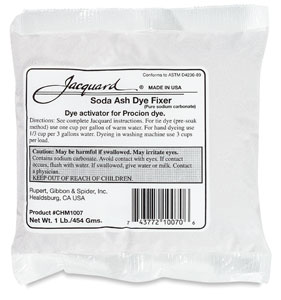
Jacquard Soda Ash
Soda ash, or sodium carbonate, is the dye fixer used with Procion MX dyes. Procion dyes with soda ash create a strong permanent chemical bond with the cotton, so they simply do not wash out. Soda ash will not work with all-purpose dye such as Rit.
Buy from Blick
Jacquard Tie Dye Kit
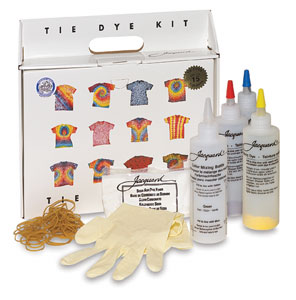
Dye up to 15 adult-size T-shirts, with vivid, electric colors that are so colorfast they can be washed with the daily laundry. Procion MX Fiber Reactive Dyes are already pre-measured for you in squeeze bottles. Just add water. Use on non-synthetic fabric.
Buy from Blick
Country or region: Minnesota
Message: I teach a group of students with behavioral issues, which means, for art, what they say they will do one day, they won't the next, then decide they'll do it two days later. Several have had great interest and success in tie dyeing. Is it possible to presoak the T-shirts in the Soda Ash, wring it out and let the shirts dry, then dampen them before tie dyeing at a later time? Or does it lose its chemical properties. I have prepared Soda Ash for 7-8 shirts and then only 3 students will participate, only to have others decide they'd like to do this a few days later. This is the nature of their approach to anything - either want it done yesterday or have to warm up to an idea. Although Soda Ash is not expensive I do have a limited budget. I appreciate your input as my internet search did not zero in on this question.
(Please help support this web site. Thank you.)
Friday, March 22, 2013
Can I restore the color of a bleach-stained foam mattress?
Name: Karen
Country or region: Northwest
Message: I have a question that is related to the FAQ on dying porous foam, but my situation is somewhat different. I have an all-foam mattress that I would like to restore to its original color. The mattress is new, but part of it was discolored when I sprayed a bleach product on it. The foam was originally white and the bleach caused the sprayed areas to turn purple and yellow. Do you know if and how I can remove the stains and restore the original foam color?I have called professional cleaners but they have never dealt with this type of issue. I am hoping that your knowledge of dyeing and different materials could help to shed some light on this problem.
I'm sorry to say that I do not believe that dyeing can solve the problem of your discolored foam. Discoloration in synthetic materials that is produced by chlorine bleach is almost invariably permanent. I don't know of any product or material that can remove the stains from bleach-damaged foam. Your best bet, if possible, would be to place a fabric cover on the mattress to conceal the stains.
(Please help support this web site. Thank you.)
batiking premium cotton makes wax removal very difficult
—ADVERTISEMENTS—
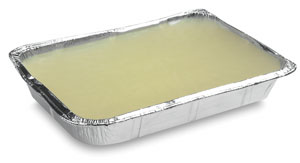
This product is a specially formulated 50/50 blend of paraffin and microcrystalline waxes. Professional quality produces the distinctive crackle effect for traditional batik.
Tjanting tools
for wax application
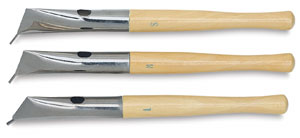
These tools are for applying wax in fine lines. Hot wax is poured into the opening. It then flows through the needle spout. You can tip the tool forward to start the wax flow, and tip it back to stop it. Tjanting Tools come in 3 different sizes.
Buy from Blick

cool water dyes will not melt your wax
Procion dyes are permanent, colorfast, and very washable. You can easily create a palette of brilliant colors ranging from light pastels to deep, vibrant hues. Perfect for natural plant fibers - cotton, linen, paper, reeds, and wood.
Buy from Blick
I read your suggestion to use Dr. Bronner's liquid castile soap in boiling water to help successfully remove batik wax from fabric.
I have learned that batiking premium cotton makes wax removal very difficult, and that bees wax tends to cling more stubbornly than paraffin. That said, I have eight lovely batik napkins that I cannot clean. The wax looks like a background shadow behind the batiked imprints. I have ironed, boiled, ironed again and boiled twice more.
How much soap per gallon should I use in the water per gallon (to try one last time to rescue my napkins?
Thank you!
Hopeful--Kathy
Hi Kathy,
Hi Paula,
Thanks for replying! I twice boiled the fabric and held it at. The bottom while it cooled completely.
I also rubbed ivory soap right on the offending wax. I then washed it in hot water and then boiled again. I'm wondering if there was too much beeswax and that the fabric is just too fine. I just can't seem to get the wax out of those tight fibers.
It may be that I have to give up on the napkins, and make them next time with quilter's Grade white cotton.
Thank you!
Kathy
(Please help support this web site. Thank you.)

cool water dyes will not melt your wax
Procion dyes are permanent, colorfast, and very washable. You can easily create a palette of brilliant colors ranging from light pastels to deep, vibrant hues. Perfect for natural plant fibers - cotton, linen, paper, reeds, and wood.
Buy from Blick

Jacquard Soda Ash
Soda ash, or sodium carbonate, is the dye fixer used with Procion MX dyes. Procion dyes with soda ash create a strong permanent chemical bond with the cotton, so they simply do not wash out. Soda ash will not work with all-purpose dye such as Rit.
Buy from Blick
Jacquard Tie Dye Kit

Dye up to 15 adult-size T-shirts, with vivid, electric colors that are so colorfast they can be washed with the daily laundry. Procion MX Fiber Reactive Dyes are already pre-measured for you in squeeze bottles. Just add water. Use on non-synthetic fabric.
Buy from Blick
Country or region: USA
Message: I am interested in using the "drip dyes" method. I am a machine knitter and would like to dye my cotton garments to resemble tie dye. When using this method how do I finish the garment out after i "batch" it? Do I wait one day to help set colors so they won't bleed together [I sell at craft shows] and then wash first in cold, once, then twice in the hottest water available, using Synthrapol in each wash, and end by double-rinsing as you state elsewhere. I'm just unsure how to finish off as I haven't used dyes much at all. Thank you, I appreciate your time on this matter.
The one thing I am not quite sure of, from your email, is whether you are planning to use the correct dyes. You cannot use this method with all-purpose dyes, such as Rit. You do appear to have a good understanding of the method, if you are planning to use Procion type fiber reactive dyes. You can buy these dyes by mail-order in many different individual colors, or you can buy a good tie-dyeing kit. I particularly like the kits made by Jacquard Products, but most brands of tie-dye kits will work fine.
My mother, Jan Burch, is a machine knitter; she advises that your yarn, or garments you have made with the yarn, must be washed before you attempt to dye them. The yarn has been treated with some sort of silicone surface treatment, which may repel the dye, resulting in poor dye uptake or in unwanted splotches. Wash the garment as usual in warm water before you attempt to dye it.
It looks like you have an excellent idea of what is required for washing out the excess unattached dye after letting the dye react. Be sure the room where you do your "batching" (allowing the dye to react with the fiber) is warm enough for the dye reaction, at least seventy degrees Fahrenheit. The knitted yarn must remain at least slightly moist for the dye reaction to occur, either by covering it with plastic, or by including urea (a humectant) in your dye mixtures.
To be sure whether you have washed out all of the excess dye, you can do a hot press test. See my page, "How can I test whether the dye will run?".
Since your yarn is made of cotton, you can finish your garments, after the washing process is complete, simply by ironing, to get them shaped right, instead of having to use a steamer as you would with some yarns, such as acrylic, so there's no problem with doing a hot press test on your knitted garments.
Paula
Actually, I think I lost myself on the finish process. Is this how I do it:
1. Batch the piece.
2. wait one day to set colors
3. wash in cold water
4. wash in hot water, twice with Synthrapol...BUT is the rinsing in warm or cold??
5. now do a double rinse in...cold?? I will be giving this a try in a month or so, I have too many projects going on at the moment, but, am very excited about trying this out. I've also, been thinking of trying the method where you dropped out dye on the kids T's. I'll be experimenting for sure.! Ha! A lot of fun ahead. Have a great day and thank you, again for your time. I appreciate your help and please tell you Mother thank you for her input on this. ;-)
Sherry
For the dye to react with the fiber, you need to apply both the Procion dye and the soda ash fixative at the same time (either putting the dye on first and the soda ash second, or putting the soda ash first and the dye second). The soda ash activates the cotton so it can react with the dye. Note that soda ash does not help all-purpose dye, such as Rit dye, fix to the yarn; you should avoid using all-purpose dyes. Fiber reactive dyes such as Procion MX perform much better and last many times longer.
It takes some time for all of the reactions between dye molecules and cotton molecules to take place, and the reactions need to be a certain temperature for it to work, so you set your yarn or garment aside, while it is still wet with the dye and soda ash. Leaving it overnight in a warm place (70 degrees Fahrenheit or warmer) allows time for the reaction to take place. This time is, obscurely, referred to as "batching", for reasons having to do with industrial dyeing techniques that need not concern us.
Once all of the dye reactions have occurred, which is to say, the next day (or the day after that if it is more convenient for you), you want to rinse out the soda ash and some of the dye, by washing once in cool water. Either room temperature or cold water is fine for this step. You don't need to use any detergent for this first wash, but it does not hurt to use Synthrapol. I like to throw the dyed material into the washing machine for this, but you can rinse in a bucket, with many changes of water, if you prefer.
Finally, you need to wash out all of the unattached excess dye. To do this, it works best to use really hot water, 140 degrees Fahrenheit or hotter. Hotter is even better. Use a small amount of Synthrapol or other detergent, and repeat the hot water wash several times. No need to pay any attention to rinsing until you have done this washing two or three times. If the washing machine proceeds to a cold rinse before you are done with the hot washing, it won't do any good, but it also won't do any harm, aside from a minor waste of water.
After all of your washing is done, rinse to remove the Synthrapol or other detergent. The washing machine rinse is fine for this. It does not matter what temperature your rinse water is, since it is pretty easy to rinse out detergent. Cold, warm or hot will all do fine. If you can still smell the detergent after one rinse, do another one.
If you are not sure whether you have gotten out all of the unattached excess dye, do the hot press test that I linked to before. This test should be done for any yarn or fabric that is going to be sold, or used together in a multi-colored piece.
There are many fun dye application techniques that can be done with the above basic method. It's such an enjoyable thing to experiment with.
Paula
(Please help support this web site. Thank you.)
Wednesday, March 06, 2013
I have dyed a pair of jeans with navy blue Dylon dye. What can I buy off the shelf or online to remove this colour ?
Country or region: England
Message: I have dyed a pair of jeans with navy blue Dylon dye and they have come out a dark navy, almost black. I should have researched this before dyeing the jeans as I now know you cannot keep the jean look using dylon dye. What can I buy off the shelf or online to remove this colour and maybe dye a different colour, i.e. dark grey, or simply fade the blue. I have read lots of reviews that Dylon pre dye does not work. Can you suggest anything else? I have looked at your links but cannot see anything available online or in the shops? Thank you in advance for your help.
(Please help support this web site. Thank you.)
Tuesday, March 05, 2013
I'm already dyeing fabric with MX dyes. Is the process the same for embroidery threads?
Country or region: Colorado
Message: I'm already dyeing fabric with MX dyes. Is the process the same for embroidery threads?
(Please help support this web site. Thank you.)
